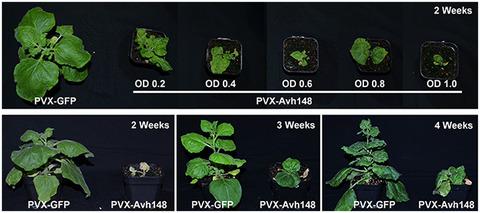当前位置:
X-MOL 学术
›
Mol. Plant Pathol.
›
论文详情
Our official English website, www.x-mol.net, welcomes your
feedback! (Note: you will need to create a separate account there.)
Establishment of a novel virus‐induced virulence effector assay for the identification of virulence effectors of plant pathogens using a PVX‐based expression vector
Molecular Plant Pathology ( IF 4.8 ) Pub Date : 2020-10-07 , DOI: 10.1111/mpp.13000 Jinxia Shi 1 , Yuanhong Zhu 1 , Ming Li 1 , Yuqing Ma 1 , Huarong Liu 1 , Peng Zhang 1, 2 , Di Fang , Yushuang Guo 3 , Ping Xu 1 , Yongli Qiao 1
Molecular Plant Pathology ( IF 4.8 ) Pub Date : 2020-10-07 , DOI: 10.1111/mpp.13000 Jinxia Shi 1 , Yuanhong Zhu 1 , Ming Li 1 , Yuqing Ma 1 , Huarong Liu 1 , Peng Zhang 1, 2 , Di Fang , Yushuang Guo 3 , Ping Xu 1 , Yongli Qiao 1
Affiliation

|
Plant pathogens deliver virulence effectors into plant cells to modulate plant immunity and facilitate infection. Although species‐specific virulence effector screening approaches have been developed for several pathogens, these assays do not apply to pathogens that cannot be cultured and/or transformed outside of their hosts. Here, we established a rapid and parallel screening assay, called the virus‐induced virulence effector (VIVE) assay, to identify putative effectors in various plant pathogens, including unculturable pathogens, using a virus‐based expression vector. The VIVE assay uses the potato virus X (PVX) vector to transiently express candidate effector genes of various bacterial and fungal pathogens into Nicotiana benthamiana leaves. Using the VIVE assay, we successfully identified Avh148 as a potential virulence effector of Phytophthora sojae. Plants infected with PVX carrying Avh148 showed strong viral symptoms and high‐level Avh148 and viral RNA accumulation. Analysis of P. sojae Avh148 deletion mutants and soybean hairy roots overexpressing Avh148 revealed that Avh148 is required for full pathogen virulence. In addition, the VIVE assay was optimized in N. benthamiana plants at different developmental stages across a range of Agrobacterium cell densities. Overall, we identified six novel virulence effectors from seven pathogens, thus demonstrating the broad effectiveness of the VIVE assay in plant pathology research.
中文翻译:

使用基于 PVX 的表达载体建立新型病毒诱导毒力效应子测定法,用于鉴定植物病原体的毒力效应子
植物病原体将毒力效应物传递到植物细胞中,调节植物免疫力并促进感染。尽管已经针对几种病原体开发了物种特异性毒力效应子筛选方法,但这些测定法不适用于无法在宿主之外培养和/或转化的病原体。在这里,我们建立了一种快速并行筛选试验,称为病毒诱导毒力效应子(VIVE)试验,使用基于病毒的表达载体来识别各种植物病原体(包括不可培养的病原体)中的假定效应子。 VIVE 检测使用马铃薯病毒 X (PVX) 载体将各种细菌和真菌病原体的候选效应基因瞬时表达到本塞姆氏烟草叶子中。使用 VIVE 检测,我们成功鉴定出 Avh148 是大豆疫霉的潜在毒力效应子。感染携带Avh148的 PVX 的植物表现出强烈的病毒症状以及高水平的Avh148和病毒 RNA 积累。对大豆青霉 Avh148缺失突变体和过表达Avh148的大豆毛状根的分析表明,Avh148 是病原体完全毒力所必需的。此外,VIVE 测定在不同发育阶段的本塞姆氏烟草植物中在不同农杆菌细胞密度范围内进行了优化。总体而言,我们从七种病原体中鉴定出了六种新型毒力效应子,从而证明了 VIVE 检测在植物病理学研究中的广泛有效性。
更新日期:2020-11-27
中文翻译:

使用基于 PVX 的表达载体建立新型病毒诱导毒力效应子测定法,用于鉴定植物病原体的毒力效应子
植物病原体将毒力效应物传递到植物细胞中,调节植物免疫力并促进感染。尽管已经针对几种病原体开发了物种特异性毒力效应子筛选方法,但这些测定法不适用于无法在宿主之外培养和/或转化的病原体。在这里,我们建立了一种快速并行筛选试验,称为病毒诱导毒力效应子(VIVE)试验,使用基于病毒的表达载体来识别各种植物病原体(包括不可培养的病原体)中的假定效应子。 VIVE 检测使用马铃薯病毒 X (PVX) 载体将各种细菌和真菌病原体的候选效应基因瞬时表达到本塞姆氏烟草叶子中。使用 VIVE 检测,我们成功鉴定出 Avh148 是大豆疫霉的潜在毒力效应子。感染携带Avh148的 PVX 的植物表现出强烈的病毒症状以及高水平的Avh148和病毒 RNA 积累。对大豆青霉 Avh148缺失突变体和过表达Avh148的大豆毛状根的分析表明,Avh148 是病原体完全毒力所必需的。此外,VIVE 测定在不同发育阶段的本塞姆氏烟草植物中在不同农杆菌细胞密度范围内进行了优化。总体而言,我们从七种病原体中鉴定出了六种新型毒力效应子,从而证明了 VIVE 检测在植物病理学研究中的广泛有效性。











































 京公网安备 11010802027423号
京公网安备 11010802027423号